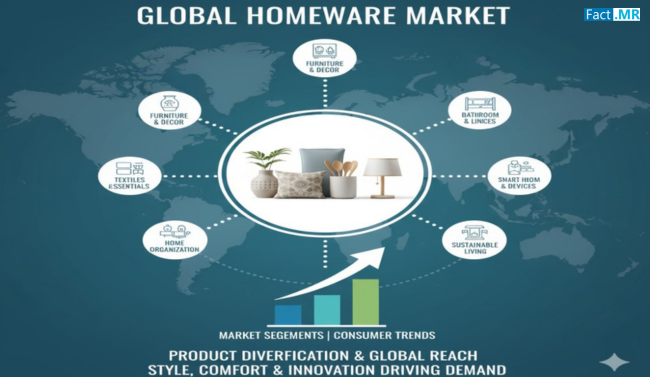The homeware market is experiencing a dynamic transformation as consumers increasingly seek products that blend functionality, aesthetics, and sustainability. From kitchenware and tableware to decorative accessories and storage solutions, homewares are becoming central to how people personalize and organize their living spaces. The market’s growth reflects the rising interest in home improvement, interior design trends, and the demand for products that enhance comfort, efficiency, and style in daily life.
Market Overview:
Homeware products encompass a wide array of items used in domestic environments, including cookware, dinnerware, glassware, textiles, and decorative pieces. Modern consumers are prioritizing multi-functional, durable, and design-oriented products that align with lifestyle trends and personal preferences.
Manufacturers are innovating with advanced materials, ergonomic designs, and sustainable production methods to meet these expectations. For example, eco-friendly materials, such as bamboo, recycled plastics, and natural fibers, are increasingly used in the production of utensils, containers, and furniture accessories.
In addition to functionality, aesthetics are a key focus in the homeware market. Minimalist designs, contemporary textures, and customizable products are appealing to consumers who want their living spaces to reflect individual taste and creativity. Digital tools, including augmented reality for home planning and online customization platforms, are enabling a more personalized shopping experience.
Regional Insights:
North America continues to be a leading market for homeware products, driven by high consumer spending on home improvement, lifestyle upgrades, and e-commerce penetration. Trends such as smart homes, multifunctional kitchens, and sustainable living are fueling demand for innovative homeware items.
Europe maintains a strong presence, with particular emphasis on eco-conscious products, design aesthetics, and premium-quality goods. Consumers in Western Europe, especially in countries with mature interior design cultures, prioritize homewares that combine style, durability, and environmental responsibility.
Asia-Pacific is emerging as a high-growth region due to urbanization, increasing disposable incomes, and rapid modernization of households. Countries like China, India, and Japan are witnessing growing demand for functional and stylish homeware products, supported by a rising online retail landscape and lifestyle-oriented consumer culture.
Latin America and the Middle East & Africa are gradually expanding as markets for homeware, supported by rising urban middle-class populations, modernization of homes, and increasing exposure to global design trends.
Key Trends & Forecast:
- Sustainability and Eco-Friendly Materials:
Consumers are prioritizing homeware products made from recycled, biodegradable, and low-impact materials. Brands that highlight environmental responsibility and sustainable sourcing practices are gaining a competitive edge. - Smart and Multifunctional Designs:
The market is witnessing the rise of multifunctional products, such as stackable storage containers, modular furniture accessories, and smart kitchen tools. These designs cater to compact urban living and enhance home organization. - Digital and E-Commerce Influence:
Online platforms have transformed the purchasing experience by providing access to a wide range of products, customization options, and home design inspiration. Direct-to-consumer models, augmented reality apps, and virtual showrooms are helping brands reach global audiences. - Customization and Personalization:
Personalized homeware, including engraved cutlery, custom-colored textiles, and bespoke decor items, is increasingly popular. Consumers are seeking products that reflect their individual style and identity. - Premium and Lifestyle Segmentation:
High-end homewares, including designer kitchenware, luxury tableware, and artisanal decorative items, are experiencing growth. These products combine craftsmanship, quality, and design to appeal to affluent consumers. - Health and Safety Considerations:
Post-pandemic consumer behavior emphasizes hygiene and safety. Antimicrobial surfaces, easy-to-clean materials, and non-toxic coatings are influencing purchasing decisions.
Applications & End-Use Outlook:
Homeware products serve a variety of consumer needs and applications:
- Kitchen and Dining:
Cookware, utensils, cutlery, tableware, and storage solutions are essential for daily culinary activities and meal presentation. Consumers increasingly value durability, functionality, and design in these items. - Home Organization and Storage:
Modular storage solutions, closet organizers, and space-saving accessories help optimize living spaces, particularly in urban homes. - Decorative and Lifestyle Accessories:
Decorative items, textiles, lighting, and wall accessories contribute to interior aesthetics, enabling consumers to personalize their homes. - Smart Home Integration:
Some homeware products are integrated with technology, such as smart kitchen appliances, automated lighting, or temperature-controlled storage solutions, enhancing convenience and lifestyle quality. - Hospitality and Commercial Use:
Hotels, resorts, and restaurants increasingly invest in premium homeware and kitchenware to enhance customer experiences and brand positioning.
Competitive Landscape:
The homeware market is highly competitive, featuring established global brands, regional manufacturers, and emerging niche players. Companies are focusing on innovation, sustainability, and design differentiation to stand out.
Collaborations with designers, lifestyle brands, and influencers are common strategies for engaging consumers and building brand loyalty. Product diversification, enhanced distribution channels, and after-sales support are additional areas of focus for companies seeking a competitive advantage.
Challenges & Opportunities:
- Challenges:
The market faces challenges such as high competition, fluctuating raw material costs, and supply chain complexities. Meeting diverse consumer preferences while maintaining sustainability and affordability can be challenging. - Opportunities:
Emerging trends in eco-friendly materials, smart home integration, and customization create significant opportunities. Rapid urbanization and growing disposable income in developing regions further expand the potential customer base.
Conclusion:
The homeware market reflects evolving consumer lifestyles and a growing emphasis on comfort, functionality, and sustainability. As innovation continues in materials, design, and technology integration, homewares are becoming more than utility items—they are expressions of style, identity, and modern living.
Companies that focus on eco-friendly practices, personalization, and digital engagement are likely to thrive, capturing the attention of discerning consumers seeking products that enhance their home environments. The future of the homeware market is poised for sustained growth, driven by creativity, innovation, and a commitment to meeting evolving lifestyle demands.



